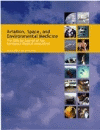
Speed and Accuracy of Head- and Eye-Based Aiming Systems at High Vertical Acceleration
Ineson J, Durnell L, Ebbage JL, Jarrett DN, Neary C, Reed MA. Speed and accuracy of head- and eye-based aiming systems at high vertical acceleration. Aviat Space Environ Med 2004; 75:420–8. Aviat Space Environ Med 2004; 75:420–428.
Background: The benefits of using a head tracker in a fast jet to aim weapons and control sensor direction have been amply demonstrated, but head direction is difficult to control at high G. An experiment was conducted to assess whether aiming using the eye, rather than the head, might be advantageous. Methods: A centrifuge provided sustained accelerations of up to 8 Gz. Participating aircrew were asked to point at static targets using head- or eye-aiming, maintain the acquisition while the target was lit, and then transfer to the next target as quickly as possible. A helmet-mounted scene camera recorded the subject’s view of the target board. A laser mounted by the scene camera was used for head-aiming and to determine head direction. The eye tracker camera and illuminator were also helmet-mounted. The eye and scene images were recorded and analyzed off-line. Results: Eye-aiming acquisition times and accuracy were affected only slightly by Gz; however, both head-aiming speed and accuracy deteriorated as Gz increased. Eye-aiming was substantially faster than head-aiming at all Gz levels, but head-aiming was more accurate under these experimental conditions. Subjective ratings supported the objective data. A majority of subjects preferred eye to head as an aiming mechanism. Conclusions: Eye-aiming was faster and easier to use than head-aiming at all Gz levels, and particularly at high Gz.
Background: The benefits of using a head tracker in a fast jet to aim weapons and control sensor direction have been amply demonstrated, but head direction is difficult to control at high G. An experiment was conducted to assess whether aiming using the eye, rather than the head, might be advantageous. Methods: A centrifuge provided sustained accelerations of up to 8 Gz. Participating aircrew were asked to point at static targets using head- or eye-aiming, maintain the acquisition while the target was lit, and then transfer to the next target as quickly as possible. A helmet-mounted scene camera recorded the subject’s view of the target board. A laser mounted by the scene camera was used for head-aiming and to determine head direction. The eye tracker camera and illuminator were also helmet-mounted. The eye and scene images were recorded and analyzed off-line. Results: Eye-aiming acquisition times and accuracy were affected only slightly by Gz; however, both head-aiming speed and accuracy deteriorated as Gz increased. Eye-aiming was substantially faster than head-aiming at all Gz levels, but head-aiming was more accurate under these experimental conditions. Subjective ratings supported the objective data. A majority of subjects preferred eye to head as an aiming mechanism. Conclusions: Eye-aiming was faster and easier to use than head-aiming at all Gz levels, and particularly at high Gz.
Keywords: control mechanisms; eye-pointing; head-pointing; selection methods; target designation
Document Type: Research Article
Publication date: 01 May 2004
- The peer-reviewed monthly journal, Aviation, Space, and Environmental Medicine (ASEM) provides contact with physicians, life scientists, bioengineers, and medical specialists working in both basic medical research and in its clinical applications. It is the most used and cited journal in its field. ASEM is distributed to more than 80 nations.
To access volumes 86 to present, please click here. - Information for Authors
- Submit a Paper
- Subscribe to this Title
- Membership Information
- Information for Advertisers
- Submit Articles
- Ingenta Connect is not responsible for the content or availability of external websites
- Access Key
- Free content
- Partial Free content
- New content
- Open access content
- Partial Open access content
- Subscribed content
- Partial Subscribed content
- Free trial content